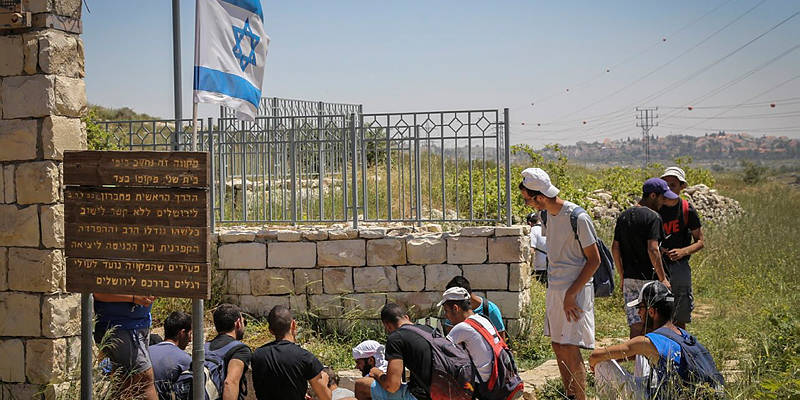Memorial Day in Israel happens to be on the day in which Kfar Etzion fell to the Jordanian Arab Legion, which massacred hundreds on that day in May, 1948.

On Israel Memorial Day (this year observed on May 11th), Israelis gathered at cemeteries and memorial services around the country. Each place has its own powerful and sad stories of soldiers and citizens who have given their lives for their love of the State of Israel and the Land of Israel. At exactly 11:00 am, a siren is sounded for 2 minutes, and the whole country stands in silence. Just at that moment, Israeli fighter jets take off near the Kfar Etzion Cemetery to fly over the National ceremony, which takes place at the Mt. Herzl Cemetery.
To stand at Kfar Etzion and experience this is awe-inspiring, because Memorial Day in Israel happens to be on the day in which Kfar Etzion fell to the Jordanian Arab Legion, which massacred hundreds on that day in May, 1948. As David Ben Gurion said eulogizing the fallen, “If Jerusalem is Jewish today, it’s because of the defenders of the Etzion Bloc.”
The stories of this area and of Jerusalem are inextricably connected, and the fighter jets flight is a powerful expression of this relationship.
There were several attempts for Jews to buy and establish communities/farms on land in the area. In the 1920s, Jews bought land near what is today called the Gush Etzion Junction. They named it Migdal Eder after the Biblical account. “So Rachel died and was buried on the way to Efrat, that is Bethlehem. Over her tomb, Jacob set up a pillar and to this day that pillar marks Rachel’s tomb. Israel moved on again and pitched his tent beyond Midgal Eder.” (Genesis 35:19-21)
This attempt failed due to the violent attacks of Arabs on Jews in 1929. In the 1930s, more land was purchased in the area by Shmuel Yosef Holzman, and the place was name Kfar Etzion as a play on words with Holzman’s name. “Holz” in German translates to wood, or “Etz” in Hebrew, and thus the name, Kfar Etzion (Etzion Village). This attempt also failed due to violence of the Great Arab Revolt of the late 1930s. Jews retuned to the land in 1943, and established 4 kibbutzim, including Kibbutz Kfar Etzion, and became known as the Etzion Bloc.
In May, 1948, in the days before the State of Israel was declared, Jordan had already entered this area, and by May 13, 1948, committed the massacre of hundreds of Jews at Kfar Etzion. On May 14, they took members of the other three kibbutzim as POWs to Jordan. Abdullah el-Tell, who led the attack on the Etzion Bloc, then went on to attack and destroy the Jewish Quarter of Jerusalem, leading to the Jews surrendering the Old City on May 28, 1948.
Every year for 19 years, the women and children who had been evacuated prior to the massacre would meet up at a lookout in Jerusalem to gaze over the Etzion Bloc area at a large 700-year-old oak tree (the only remaining tree in the area because it was considered holy to the local Arabs) and remember the days they had spent there, building their homes and farming the land, and remembering their fathers who had been murdered. They were determined to return to their homes. In June, 1967, in the miraculous 6 Day War, the Etzion Bloc area (also known as part of the West Bank), came under Israeli control. The children were finally able to return, and did so immediately.
By July, 1967, Kibbutz Kfar Etzion was re-established in its original place. In 1970, Alon Shvut (meaning “return to the Oak tree”) was established nearby, and today there are over 70,000 Jews in 22 communities (often referred to in the media as “settlements,”) in the area. The original name, Kfar Etzion (named after Holzman), amazingly turned out to be somewhat prophetic.
Another remarkable “coincidence” is that Memorial Day happens to now be observed on the day that the Etzion Bloc fell. Originally, the two days were observed together, on the same day, because no one could imagine separating the grief of the losses of those who fought to establish the Jewish State from the joy of the establishment of the State. But after a few years, of celebrating together with mourning, it was decided that it was technically problematic. So Memorial Day was moved to one day earlier. That way, they would still be together, but each would have its own day. As a result, Memorial Day falls out on the day of the Kfar Etzion massacre.
If you go to Kfar Etzion (where they have a visitor center and sound and light show about the history), make sure to ask to meet some of the children (now in their 70s) who returned to rebuild, and you will certainly have a very meaningful experience, whichever day of the year it happens to be.
By: Leah Bowman
(The author, a licensed tour guide, leads inspiring tours throughout Israel, including child-friendly and bible tours. Check out her website and blog page.)
